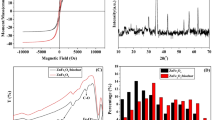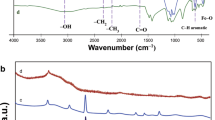Abstract
The accumulation of heavy metal ions in living cells leads to biological damage, which makes the necessity of using new methods to effectively remove heavy metal ions from the environment more vital. In this work, a magnetic modified biochar was prepared under regular air atmosphere and low temperature (220 ºC) and used as a low-cost and green adsorbent for efficient adsorptive removal of cobalt (Co(II)) and Lead (Pb(II)) ions from contaminated waters. The adsorption process was modeled and optimized using CCD-RSM to maximize the removal efficiency of heavy metal ions, as well as was monitored in detail by isotherm, kinetic, and thermodynamic studies. The results show that the Langmuir maximum adsorption capacity of the adsorbent reached 237.92 mg g−1 (single) and 121.23 mg g−1 (binary) for Co(II) and 207.21 mg g−1 (single) and 106.56 mg g−1 (binary) for Pb(II) under the short time of 25 min and solution pH of 6.0. The kinetic studies revealed that the pseudo-first-order model was the best-fitted model to experimental data and indicated that the adsorption process was mostly through chemisorption. Also, thermodynamic studies showed that that adsorptive removal of Co(II)and Pb(II)ions followed an endothermic and spontaneous process. The reusability studies demonstrated that the adsorbent could be successfully regenerated with 5 mL of 0.1 mol L−1 HNO3 solution, and the adsorption efficiency was retaining about 90% after four adsorption–desorption cycles. Also, the results from using real water samples, including drinking water, groundwater, and river water, implied that the synthesized magnetic modified biochar was highly efficient for practical treatment processes. Overall, the results indicated that the proposed magnetic biochar can be considered as a cost-effective and efficient adsorbent for adsorptive removal of heavy metal ions from contaminated waters.












Similar content being viewed by others
Data availability
Data will be made available on request.
References
Abbas M (2021) Modeling of adsorption isotherms of heavy metals onto apricot stone activated carbon: two-parameter models and equations allowing determination of thermodynamic parameters. Mater Today: Proc 43:3359–3364. https://doi.org/10.1016/j.matpr.2020.05.320
Arabkhani P, Asfaram A (2020) Development of a novel three-dimensional magnetic polymer aerogel as an efficient adsorbent for malachite green removal. J Hazard Mater 384:121394. https://doi.org/10.1016/j.jhazmat.2019.121394
Arabkhani P, Asfaram A (2022) The potential application of bio-based ceramic/organic xerogel derived from the plant sources: a new green adsorbent for removal of antibiotics from pharmaceutical wastewater. J Hazard Mater 429:128289. https://doi.org/10.1016/j.jhazmat.2022.128289
Arabkhani P, Javadian H, Asfaram A et al (2021a) Decorating graphene oxide with zeolitic imidazolate framework (ZIF-8) and pseudo-boehmite offers ultra-high adsorption capacity of diclofenac in hospital effluents. Chemosphere 271:129610. https://doi.org/10.1016/j.chemosphere.2021.129610
Arabkhani P, Javadian H, Asfaram A et al (2021b) A reusable mesoporous adsorbent for efficient treatment of hazardous triphenylmethane dye wastewater: RSM-CCD optimization and rapid microwave-assisted regeneration. Sci Rep 11:22751. https://doi.org/10.1038/s41598-021-02213-2
Arabkhani P, Sadegh N, Shahamat M et al (2023) Glucose-assisted synthesis of a magnetic monohydroxy aluminium oxide@carbon (γ-AlOOH/Fe3O4@C) nanocomposite as an innovative sorbent for extraction and pre-concentration of deferasirox present in plasma and urine samples. New J Chem 47:453–461. https://doi.org/10.1039/D2NJ04107C
Belhachemi M, Addoun F (2011) Comparative adsorption isotherms and modeling of methylene blue onto activated carbons. Appl Water Sci 1:111–117. https://doi.org/10.1007/s13201-011-0014-1
Bhattacharyya KG, Gupta SS (2007) Adsorptive accumulation of Cd(II), Co(II), Cu(II), Pb(II), and Ni(II) from water on montmorillonite: influence of acid activation. J Colloid Interface Sci 310:411–424. https://doi.org/10.1016/j.jcis.2007.01.080
Chandraiah MR (2016) Facile synthesis of zero valent iron magnetic biochar composites for Pb (II) removal from the aqueous medium. Alex Eng J 55:619–625. https://doi.org/10.1016/j.aej.2015.12.015
Es-sahbany H, Hsissou R, El Hachimi ML et al (2021) Investigation of the adsorption of heavy metals (Cu Co, Ni and Pb) in treatment synthetic wastewater using natural clay as a potential adsorbent (Sale-Morocco). Mater Today: Proc 45:7290–7298. https://doi.org/10.1016/j.matpr.2020.12.1100
Farshchi HK, Azizi M, Jaafari MR et al (2018) Green synthesis of iron nanoparticles by rosemary extract and cytotoxicity effect evaluation on cancer cell lines. Biocatal Agric Biotechnol 16:54–62. https://doi.org/10.1016/j.bcab.2018.07.017
Ge Q, Tian Q, Moeen M et al. (2020) Facile synthesis of cauliflower leaves biochar at low temperature in the air atmosphere for Cu(II) and Pb(II) removal from water. Mater 13. https://doi.org/10.3390/ma13143163
Ghaedi M, Rozkhoosh Z, Asfaram A et al (2015) Comparative studies on removal of erythrosine using ZnS and AgOH nanoparticles loaded on activated carbon as adsorbents: kinetic and isotherm studies of adsorption. Spectrochim Acta A Mol Biomol 138:176–186. https://doi.org/10.1016/j.saa.2014.10.046
Ghassabzadeh H, Torab-Mostaedi M, Mohaddespour A et al (2010) Characterizations of Co (II) and Pb (II) removal process from aqueous solutions using expanded perlite. Desalination 261:73–79. https://doi.org/10.1016/j.desal.2010.05.028
Hamza UD, Nasri NS, Amin NS et al (2016) Characteristics of oil palm shell biochar and activated carbon prepared at different carbonization times. Desalin Water Treat 57:7999–8006. https://doi.org/10.1080/19443994.2015.1042068
Hoppen MI, Carvalho KQ, Ferreira RC et al (2019) Adsorption and desorption of acetylsalicylic acid onto activated carbon of babassu coconut mesocarp. J Environ Chem Eng 7:102862. https://doi.org/10.1016/j.jece.2018.102862
Hu X, Ding Z, Zimmerman AR et al (2015) Batch and column sorption of arsenic onto iron-impregnated biochar synthesized through hydrolysis. Water Res 68:206–216. https://doi.org/10.1016/j.watres.2014.10.009
Huang Y, Zheng H, Li H et al (2021) Highly effective and selective adsorption of thorium (IV) from aqueous solution using mesoporous graphite carbon nitride prepared by sol–gel template method. Chem Eng J 410:128321. https://doi.org/10.1016/j.cej.2020.128321
Jadali S, Sajjadi SM, Zavvar Mousavi H et al (2017) Combination of experimental design and desirability function as a genuine method to achieve common optimal conditions for the adsorption of Pb (II) and Cu (II) onto the poplar tree leaves: equilibrium, kinetic and thermodynamic studies. Anal Bioanal Chem 4:171–187. https://doi.org/10.22036/abcr.2016.67517.1122
Joseph IV, Tosheva L, Doyle AM (2020) Simultaneous removal of Cd(II), Co(II), Cu(II), Pb(II), and Zn(II) ions from aqueous solutions via adsorption on FAU-type zeolites prepared from coal fly ash. J Environ Chem Eng 8:103895. https://doi.org/10.1016/j.jece.2020.103895
Kalam S, Abu-Khamsin SA, Kamal MS et al (2021) Surfactant adsorption isotherms: a review. ACS Omega 6:32342–32348. https://doi.org/10.1021/acsomega.1c04661
Kasiri E, Arabkhani P, Haddadi H et al (2022) A silanized magnetic amino-functionalized carbon nanotube-based multi-ion imprinted polymer for the selective aqueous decontamination of heavy metal ions. New J Chem 46:21704–21716. https://doi.org/10.1039/D2NJ04105G
Khalid AM, Hossain MS, Khalil NA et al (2023) Adsorptive elimination of heavy metals from aqueous solution using magnetic chitosan/cellulose-Fe (III) composite as a bio-sorbent. Nanomater 13:1595. https://doi.org/10.3390/nano13101595
Kliškić M, Radošević J, Gudic S et al (2000) Aqueous extract of Rosmarinus officinalis L. as inhibitor of Al–Mg alloy corrosion in chloride solution. J Appl Electrochem 30:823–830. https://doi.org/10.1023/A:1004041530105
Kong Q, Shi X, Ma W et al (2021) Strategies to improve the adsorption properties of graphene-based adsorbent towards heavy metal ions and their compound pollutants: a review. J Hazard Mater 415:125690. https://doi.org/10.1016/j.jhazmat.2021.125690
Kumar R, Rani M, Gupta H et al (2014) Trace metal fractionation in water and sediments of an urban river stretch. Chem Speciat Bioavailab 26:200–209. https://doi.org/10.3184/095422914X14142369069568
Mehrabi F, Vafaei A, Ghaedi M et al (2017) Ultrasound assisted extraction of Maxilon Red GRL dye from water samples using cobalt ferrite nanoparticles loaded on activated carbon as sorbent: optimization and modeling. Ultrason Sonochem 38:672–680. https://doi.org/10.1016/j.ultsonch.2016.08.012
Mehta D, Mazumdar S, Singh SK (2015) Magnetic adsorbents for the treatment of water/wastewater—a review. J Water Process Eng 7:244–265. https://doi.org/10.1016/j.jwpe.2015.07.001
Mohapatra, M., L. Mohapatra, P. Singh, et al. 2010. A comparative study on Pb (II), Cd (II), Cu (II), Co (II) adsorption from single and binary aqueous solutions on additive assisted nano-structured goethite. Int J Eng Sci 2. https://doi.org/10.4314/ijest.v2i8.63784
Motaghi H, Arabkhani P, Parvinnia M et al (2022b) Synthesis of a highly porous three-dimensional PVA/GO/ZIF-67 cryogel for the simultaneous treatment of water contaminated with cadmium(ii) and lead(ii) heavy metal ions. New J Chem 46:4449–4461. https://doi.org/10.1039/d1nj05418j
Motaghi H, Arabkhani P, Parvinnia M et al. (2022) Simultaneous adsorption of cobalt ions, azo dye, and imidacloprid pesticide on the magnetic chitosan/activated carbon@UiO-66 bio-nanocomposite: optimization, mechanisms, regeneration, and application. Sep Purif Technol 284. https://doi.org/10.1016/j.seppur.2021.120258
Nayak R, Dey T, Ghosh PC et al (2016) Phosphoric acid doped poly(2,5-benzimidazole)-based proton exchange membrane for high temperature fuel cell application. Polym Eng Sci 56:1366–1374. https://doi.org/10.1002/pen.24370
Poonam R, Bharti SK, Kumar N (2018) Kinetic study of lead (Pb2+) removal from battery manufacturing wastewater using bagasse biochar as biosorbent. Appl Water Sci 8:119. https://doi.org/10.1007/s13201-018-0765-z
Rashidi NA, Yusup S, Borhan A (2016) Isotherm and thermodynamic analysis of carbon dioxide on activated carbon. Procedia Eng 148:630–637. https://doi.org/10.1016/j.proeng.2016.06.527
Sharifpour E, Arabkhani P, Sadegh F et al. (2022) In-situ hydrothermal synthesis of CNT decorated by nano ZnS/CuO for simultaneous removal of acid food dyes from binary water samples. Sci Rep 12. https://doi.org/10.1038/s41598-022-16676-4
Shojaeipoor F, Elhamifar D, Moshkelgosha R et al (2016) Removal of Pb(II) and Co(II) ions from aqueous solution and industrial wastewater using ILNO-NH2: Kinetic, isotherm and thermodynamic studies. J Taiwan Inst Chem Eng 67:166–173. https://doi.org/10.1016/j.jtice.2016.07.008
Thommes M, Kaneko K, Neimark AV et al (2015) Physisorption of gases, with special reference to the evaluation of surface area and pore size distribution (IUPAC Technical Report). Pure Appl Chem 87:1051–1069. https://doi.org/10.1515/pac-2014-1117
Unnithan MR, Anirudhan T (2001) The kinetics and thermodynamics of sorption of chromium (VI) onto the iron (III) complex of a carboxylated polyacrylamide-grafted sawdust. Ind Eng Chem Res 40:2693–2701. https://doi.org/10.1021/ie0009740
Vakili M, Deng S, Cagnetta G et al (2019) Regeneration of chitosan-based adsorbents used in heavy metal adsorption: a review. Sep Purif Technol 224:373–387. https://doi.org/10.1016/j.seppur.2019.05.040
Wang H, Gao B, Wang S et al (2015) Removal of Pb (II), Cu (II), and Cd (II) from aqueous solutions by biochar derived from KMnO4 treated hickory wood. Bioresour Technol 197:356–362. https://doi.org/10.1016/j.biortech.2015.08.132
Yoder J, Galinato S, Granatstein D et al (2011) Economic tradeoff between biochar and bio-oil production via pyrolysis. Biomass Bioenergy 35:1851–1862. https://doi.org/10.1016/j.biombioe.2011.01.026
Zhang M, Gao B, Varnoosfaderani S et al (2013) Preparation and characterization of a novel magnetic biochar for arsenic removal. Bioresour Technol 130:457–462. https://doi.org/10.1016/j.biortech.2012.11.132
Zhao X, Zhang G, Jia Q et al (2011) Adsorption of Cu(II), Pb(II), Co(II), Ni(II), and Cd(II) from aqueous solution by poly(aryl ether ketone) containing pendant carboxyl groups (PEK-L): equilibrium, kinetics, and thermodynamics. Chem Eng J 171:152–158. https://doi.org/10.1016/j.cej.2011.03.080
Zhao F, Tang WZ, Zhao D et al (2014) Adsorption kinetics, isotherms and mechanisms of Cd(II), Pb(II), Co(II) and Ni(II) by a modified magnetic polyacrylamide microcomposite adsorbent. J Water Process Eng 4:47–57. https://doi.org/10.1016/j.jwpe.2014.09.003
Zhou Y, Wang X, Zhang M et al (2014) Removal of Pb(II) and malachite green from aqueous solution by modified cellulose. Cellulose 21:2797–2809. https://doi.org/10.1007/s10570-014-0282-7
Funding
The authors received financial support from the Yasuj University of Medical Sciences (IR.YUMS.REC.1400.187), Yasuj, Iran.
Author information
Authors and Affiliations
Contributions
All authors contributed to the study conception and design. Payam Arabkhani: writing — original draft, investigation, data curation, formal analysis, writing — review and editing. Arash Asfaram: supervision, conceptualization, writing — original draft, writing — review and editing, methodology; data curation; validation. Fatemeh Sadegh: writing — original draft; validation.
Corresponding author
Ethics declarations
Ethical approval
This study did not involve any in vivo experiments and does not apply to any ethical approval necessary.
Consent to participate
Not applicable.
Consent for publication
Not applicable.
Competing interests
The authors declare no competing interests.
Additional information
Responsible Editor: Tito Roberto Cadaval Jr
Publisher's Note
Springer Nature remains neutral with regard to jurisdictional claims in published maps and institutional affiliations.
Rights and permissions
Springer Nature or its licensor (e.g. a society or other partner) holds exclusive rights to this article under a publishing agreement with the author(s) or other rightsholder(s); author self-archiving of the accepted manuscript version of this article is solely governed by the terms of such publishing agreement and applicable law.
About this article
Cite this article
Arabkhani, P., Asfaram, A. & Sadegh, F. Green and low-temperature synthesis of the magnetic modified biochar under the air atmosphere for the adsorptive removal of heavy metal ions from wastewater: CCD-RSM experimental design with isotherm, kinetic, and thermodynamic studies. Environ Sci Pollut Res 30, 120085–120102 (2023). https://doi.org/10.1007/s11356-023-30469-w
Received:
Accepted:
Published:
Issue Date:
DOI: https://doi.org/10.1007/s11356-023-30469-w




